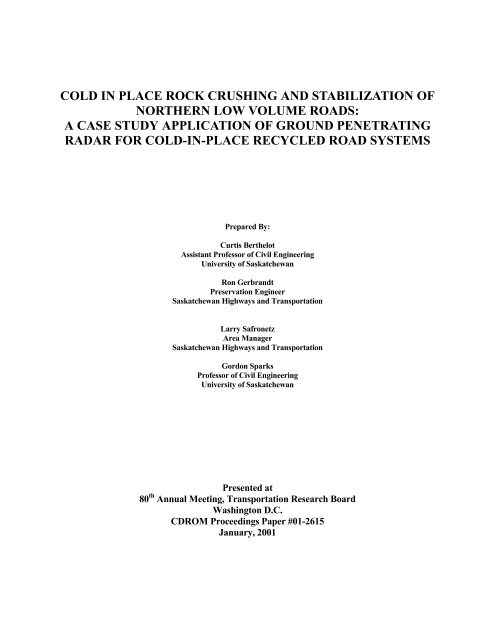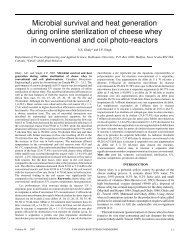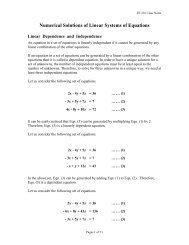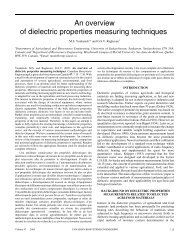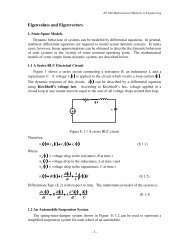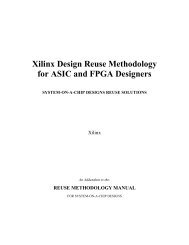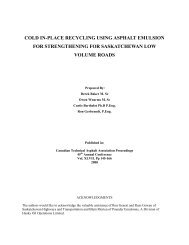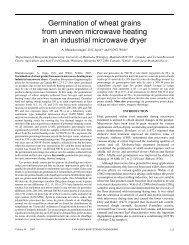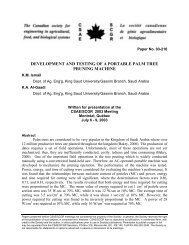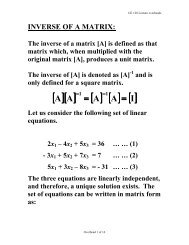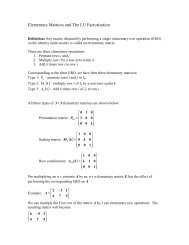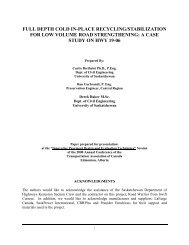Cold in Place Rock Crushing and Stabilization of Northern Low ...
Cold in Place Rock Crushing and Stabilization of Northern Low ...
Cold in Place Rock Crushing and Stabilization of Northern Low ...
You also want an ePaper? Increase the reach of your titles
YUMPU automatically turns print PDFs into web optimized ePapers that Google loves.
COLD IN PLACE ROCK CRUSHING AND STABILIZATION OFNORTHERN LOW VOLUME ROADS:A CASE STUDY APPLICATION OF GROUND PENETRATINGRADAR FOR COLD-IN-PLACE RECYCLED ROAD SYSTEMSPrepared By:Curtis BerthelotAssistant Pr<strong>of</strong>essor <strong>of</strong> Civil Eng<strong>in</strong>eer<strong>in</strong>gUniversity <strong>of</strong> SaskatchewanRon Gerbr<strong>and</strong>tPreservation Eng<strong>in</strong>eerSaskatchewan Highways <strong>and</strong> TransportationLarry SafronetzArea ManagerSaskatchewan Highways <strong>and</strong> TransportationGordon SparksPr<strong>of</strong>essor <strong>of</strong> Civil Eng<strong>in</strong>eer<strong>in</strong>gUniversity <strong>of</strong> SaskatchewanPresented at80 th Annual Meet<strong>in</strong>g, Transportation Research BoardWash<strong>in</strong>gton D.C.CDROM Proceed<strong>in</strong>gs Paper #01-2615January, 2001
Berthelot, Gerbr<strong>and</strong>t, Safronetz, <strong>and</strong> Sparks. Page: 1ABSTRACTSaskatchewan Department <strong>of</strong> Highways <strong>and</strong> Transportation (SDHT) is responsible for ma<strong>in</strong>ta<strong>in</strong><strong>in</strong>gapproximately 6500 kilometers <strong>of</strong> northern gravel surfaced roads. Many <strong>of</strong> these northern gravel roads are built onpoorly graded s<strong>and</strong> subgrades <strong>and</strong> may conta<strong>in</strong> protrud<strong>in</strong>g bedrock <strong>and</strong>/or large boulders. Because <strong>of</strong> this,washboard<strong>in</strong>g, protrud<strong>in</strong>g rocks, rutt<strong>in</strong>g <strong>and</strong> potholes are common performance problems <strong>of</strong> many northern gravelroads. Rout<strong>in</strong>e blad<strong>in</strong>g <strong>of</strong> these roads is <strong>of</strong>ten <strong>in</strong>effective because unstable s<strong>and</strong> does not ma<strong>in</strong>ta<strong>in</strong> its shape <strong>and</strong>compaction, protrud<strong>in</strong>g bedrock <strong>and</strong> boulders damage motor grader blades, boulders may become dislodged leav<strong>in</strong>gholes <strong>in</strong> the road, <strong>and</strong> dislodged boulders are a safety hazard when w<strong>in</strong>drowed along road side-slopes. Clay capp<strong>in</strong>g<strong>and</strong> base stabilization have been used to provide a stable wear<strong>in</strong>g surface, cover protrud<strong>in</strong>g bedrock <strong>and</strong> largeboulders, <strong>and</strong> reduce traffic dust. However, the long-term performance <strong>of</strong> clay capp<strong>in</strong>g <strong>and</strong> base stabilization can behighly variable <strong>and</strong> the associated costs can make these conventional solutions untenable. As a result, SDHT<strong>in</strong>vestigated the use <strong>of</strong> <strong>in</strong>-place rock crush<strong>in</strong>g <strong>and</strong> stabilization/modification for northern gravel roads withsignificant proportion <strong>of</strong> boulders <strong>in</strong> the grade us<strong>in</strong>g a rotomixer/stabilizer. Based on the f<strong>in</strong>d<strong>in</strong>gs <strong>of</strong> this study, <strong>in</strong>placerock crush<strong>in</strong>g <strong>and</strong> stabilization/modification is a technically feasible solution for elim<strong>in</strong>at<strong>in</strong>g protrud<strong>in</strong>gbedrock <strong>and</strong> boulders conta<strong>in</strong>ed near the surface. However, <strong>in</strong>-place crush<strong>in</strong>g <strong>of</strong> boulders with unconf<strong>in</strong>edcompressive strengths over 50,000 psi resulted <strong>in</strong> significant damage to the rotomixer m<strong>and</strong>rel result<strong>in</strong>g <strong>in</strong> anapproximate cost <strong>of</strong> just under $13,684 CDN per kilometer. <strong>in</strong> situ rock crush<strong>in</strong>g with subgrade stabilization <strong>and</strong>double seal was found to cost approximately $52,017 CDN per kilometer.
Berthelot, Gerbr<strong>and</strong>t, Safronetz, <strong>and</strong> Sparks. Page: 21 INTRODUCTIONSaskatchewan Department <strong>of</strong> Highways <strong>and</strong> Transportation (SDHT) is responsible for ma<strong>in</strong>ta<strong>in</strong><strong>in</strong>gapproximately 6500 kilometers <strong>of</strong> northern gravel roads. Many <strong>of</strong> these gravel roads are built on poorly graded s<strong>and</strong>subgrades <strong>and</strong> may conta<strong>in</strong> protrud<strong>in</strong>g bedrock <strong>and</strong>/or large boulders. Because <strong>of</strong> this, these roads may exhibit washboard<strong>in</strong>g, protrud<strong>in</strong>g rocks, rutt<strong>in</strong>g <strong>and</strong> potholes which results <strong>in</strong> decreased service level <strong>and</strong> potential driv<strong>in</strong>g hazards.Rout<strong>in</strong>e blad<strong>in</strong>g is <strong>of</strong>ten <strong>in</strong>effective because unstable s<strong>and</strong> does not ma<strong>in</strong>ta<strong>in</strong> its shape <strong>and</strong> compaction, protrud<strong>in</strong>gbedrock <strong>and</strong> boulders damage motor grader blades, boulders may become dislodged leav<strong>in</strong>g holes <strong>in</strong> the road, <strong>and</strong>dislodged boulders are a safety hazard when w<strong>in</strong>drowed along road side-slopes.In the past, clay capp<strong>in</strong>g <strong>and</strong> base stabilization have been used to provide a stable wear<strong>in</strong>g surface, coverprotrud<strong>in</strong>g bedrock <strong>and</strong> large boulders, <strong>and</strong> reduce traffic dust (1). However, the long-term performance <strong>of</strong> clay capp<strong>in</strong>g<strong>and</strong> base stabilization can be highly variable <strong>and</strong> the associated costs can make them untenable. As a result, significantbenefits could result from a more effective ma<strong>in</strong>tenance <strong>and</strong> upgrade treatment for northern gravel roads characterized byprotrud<strong>in</strong>g boulders <strong>and</strong> bedrock <strong>and</strong>/or comprised <strong>of</strong> unstable s<strong>and</strong> subgrades. In the search for more appropriatemethods for ma<strong>in</strong>ta<strong>in</strong><strong>in</strong>g northern gravel roads, an <strong>in</strong>-place rock crush<strong>in</strong>g <strong>and</strong> stabilization pilot project was undertakenon Highway 918-01 <strong>in</strong> 1999 between kilometers 12.80 <strong>and</strong> 21.84.Historic performance problems with Highway 918-01 <strong>in</strong>clude rough road surface due to severe potholes,rutt<strong>in</strong>g, protrud<strong>in</strong>g boulders <strong>and</strong> washboard<strong>in</strong>g. Rout<strong>in</strong>e blad<strong>in</strong>g <strong>of</strong> Highway 918-01 has been relatively <strong>in</strong>effective dueto unstable subgrade conditions <strong>and</strong> protrud<strong>in</strong>g boulders. Commercial traffic on Highway 918-01 is limited to suppliesto the Patunak First Nations Reservation, which is comprised <strong>of</strong> approximately 1500 residents. There is no residential orcommercial development along Highway 918-01.2 PRELIMINARY SITE INVESTIGATIONA prelim<strong>in</strong>ary site <strong>in</strong>vestigation <strong>and</strong> visual site survey was performed along Highway 918-01 <strong>in</strong> early summer1999. Figure 1 <strong>and</strong> Figure 2 show protrud<strong>in</strong>g boulders <strong>and</strong> unstable s<strong>and</strong> subgrade conditions common to Highway918-01.
Berthelot, Gerbr<strong>and</strong>t, Safronetz, <strong>and</strong> Sparks. Page: 3FIGURE 1 Highway 918-01 Typical Boulders In Grade <strong>and</strong> Along Road EdgeFIGURE 2 Highway 918-01 Typical Unstable S<strong>and</strong> Subgrade
Berthelot, Gerbr<strong>and</strong>t, Safronetz, <strong>and</strong> Sparks. Page: 4In situ subgrade soil samples were retrieved from Highway 918-01. The result<strong>in</strong>g gra<strong>in</strong> size analysis from eachsample is illustrated <strong>in</strong> Figure 3. As seen <strong>in</strong> Figure 3, Highway 918-01 subgrade is comprised <strong>of</strong> uniform s<strong>and</strong> withapproximately 15 to 20 percent f<strong>in</strong>es. Atterburg limit characterization <strong>of</strong> the f<strong>in</strong>es portion determ<strong>in</strong>ed the f<strong>in</strong>es portion tobe non-plastic. AASHTO classification determ<strong>in</strong>ed the subgrade to be non-plastic f<strong>in</strong>e s<strong>and</strong> (A-3) <strong>and</strong> the Unified SoilClassification System determ<strong>in</strong>ed the subgrade to be poorly graded s<strong>and</strong> with high non-plastic f<strong>in</strong>es content (SM).St<strong>and</strong>ard Proctor moisture density characterization was performed as per ASTM protocols <strong>and</strong> is shown <strong>in</strong> Figure 4. Ascan be seen <strong>in</strong> Figure 4, the optimum st<strong>and</strong>ard proctor density was found to be approximately 2070 kg/m 3 at 7.5 percentmoisture content <strong>and</strong> the optimum modified proctor density was found to be approximately 2160 kg/m 3 at 6.5 percentmoisture content.100908070% Pass<strong>in</strong>g6050403020100.075 .25.15.425.852.04.75 6.3Sieve Size 0.45 (mm)9.512.519.0Kilometer 10 Kilometer 20FIGURE 3 Highway 918-01 <strong>in</strong> situ Subgrade Gra<strong>in</strong> Size Distribution
Berthelot, Gerbr<strong>and</strong>t, Safronetz, <strong>and</strong> Sparks. Page: 52180215521302105Dry Density (kg/m 3 )2080205520302005198019551930190518803 4 5 6 7 8 9 10Moisture Content Percent11Modified ProctorSt<strong>and</strong>ard ProctorFIGURE 4 St<strong>and</strong>ard <strong>and</strong> Modified Proctor Moisture-Density <strong>of</strong> SDHT Highway 918-01 SubgradeIn situ boulders were sampled from Highway 918-01, were identified as to their type, <strong>and</strong> characterized withrespect to unconf<strong>in</strong>ed compressive strength. The rock type identification <strong>and</strong> unconf<strong>in</strong>ed compressive strengthmeasurements are summarized <strong>in</strong> Table 1 <strong>and</strong> illustrated <strong>in</strong> Figure 5. As seen <strong>in</strong> Table 1 <strong>and</strong> Figure 5, the <strong>in</strong> situboulders exhibited mean unconf<strong>in</strong>ed compressive strengths rang<strong>in</strong>g from 121.1 MPa (24.0 ksi) for weathered granitoidto 358.1 MPa (51.9 ksi) for f<strong>in</strong>e-gra<strong>in</strong>ed metamorphic basalt.
Berthelot, Gerbr<strong>and</strong>t, Safronetz, <strong>and</strong> Sparks. Page: 6TABLE 1 Highway 918-01 <strong>in</strong> situ <strong>Rock</strong> Unconf<strong>in</strong>ed Compressive Strength Measurements<strong>Rock</strong> TypeSampleLength(mm)SampleWidth(mm)SampleL/DRatioLoad(KN)UCS(ksi)UCS(MPa)F<strong>in</strong>e Gra<strong>in</strong>ed Metamorphic A 80.7 38.5 2.10 431 53.8 370.7F<strong>in</strong>e Gra<strong>in</strong>ed Metamorphic B 84.3 38.5 2.37 402 50.1 345.5Granite A 82.1 38.5 2.13 318 39.7 273.7Granite B 80.7 38.6 2.09 316 39.2 269.8Pegamite A 74.9 38.5 1.95 281 35.0 241.4Pegamite B 80.7 38.5 2.10 243 30.3 208.9P<strong>in</strong>k Granitoid A 82.8 38.6 2.15 185 23.0 158.6P<strong>in</strong>k Granitoid B 82.5 38.6 2.14 241 29.8 205.6Weathered Granitoid A 76.7 38.6 1.99 185 22.9 157.8Weathered Granitoid B 80.6 38.6 2.09 214 26.5 182.5Weathered Granitoid A* 82.5 38.5 2.14 82 10.2 70.1Weathered Granitoid B 84.9 38.5 2.21 200 25.0 172.0Grey Granitoid A 81.1 38.6 2.10 160 19.9 136.9Grey Granitoid B 81.2 38.6 2.10 234 29.0 199.8* Sample conta<strong>in</strong>ed <strong>in</strong>ternal fracture plane.MeanUCS(MPa)358.1271.8225.1182.1170.2121.1168.4400350358Mean UCS (MPa)300250200150100271225182170168121500F<strong>in</strong>e Gra<strong>in</strong>ed MetamorphicGranitePegamiteP<strong>in</strong>k GranitoidWeathered GranitoidGrey GranitoidWeathered Granitoid FracturedFIGURE 5 SDHT Hwy 918-01 <strong>in</strong> situ <strong>Rock</strong> Unconf<strong>in</strong>ed Compressive Strength Measurements
Berthelot, Gerbr<strong>and</strong>t, Safronetz, <strong>and</strong> Sparks. Page: 73 TEST SECTION DESIGN, LAYOUT, AND CONSTRUCTIONThe test sections constructed on SDHT Hwy 918-01were designed <strong>and</strong> constructed around the objective toevaluate the effectiveness <strong>of</strong> crush<strong>in</strong>g protrud<strong>in</strong>g boulders <strong>in</strong>-place, <strong>and</strong> stabiliz<strong>in</strong>g the <strong>in</strong> situ gravel road s<strong>and</strong> subgrade.The stabilizers considered <strong>in</strong> this study <strong>in</strong>cluded low plastic clay, calcium chloride, DL10 Special asphalt emulsion, <strong>and</strong>SS-1 asphalt emulsion. The <strong>in</strong>-place rock crush<strong>in</strong>g <strong>and</strong> stabilization test sections constructed as part <strong>of</strong> the Highway918-01 test site <strong>in</strong>clude:a) In-place rock crush<strong>in</strong>g, reshap<strong>in</strong>g, <strong>and</strong> recompaction with no stabilization (control section).b) In-place rock crush<strong>in</strong>g, reshap<strong>in</strong>g, recompaction <strong>and</strong> surface modification with low plastic clay.c) In-place rock crush<strong>in</strong>g, reshap<strong>in</strong>g, recompaction <strong>and</strong> stabilization/modification with calcium chloride.d) In-place rock crush<strong>in</strong>g, reshap<strong>in</strong>g, recompaction <strong>and</strong> stabilization/modification with low plastic clay <strong>and</strong>calcium chloride.e) In-place rock crush<strong>in</strong>g, reshap<strong>in</strong>g, recompaction <strong>and</strong> stabilization with DL-10 asphalt emulsion.f) In-place rock crush<strong>in</strong>g, reshap<strong>in</strong>g, recompaction <strong>and</strong> stabilization with SS-1 asphalt emulsion.Stabilizer concentrations <strong>and</strong> layer thicknesses were based on the characterization results <strong>of</strong> the subgrade <strong>and</strong>the properties <strong>of</strong> the alternative stabilizers/modifiers considered <strong>in</strong> this study. The stabilized test sections aresummarized <strong>in</strong> Table 2. As seen <strong>in</strong> Table 2, the asphalt emulsion stabilized test sections considered <strong>in</strong> this study<strong>in</strong>cluded the addition <strong>of</strong> DL10 Special <strong>and</strong> SS-1 at concentrations <strong>of</strong> 2.5, 4.5 <strong>and</strong> 6.5 percent. Given a residual asphaltcement content <strong>of</strong> approximately 60 percent, the residual asphalt cement content <strong>in</strong> the field was 1.5, 2.7 <strong>and</strong> 3.9 percentby dry weight <strong>of</strong> soil respectively. Table 3 summarizes <strong>and</strong> Figure 6 illustrates the Marshall stability after a seven-daycure <strong>and</strong> the reta<strong>in</strong>ed Marshall stability after a seven-day cure <strong>and</strong> a 48 hour soak <strong>of</strong> each SDHT Hwy 918-01 stabilizedmaterial system. Marshall stability was chosen as the relative measure <strong>of</strong> stability because it is commonly understood<strong>and</strong> well referenced. As also seen <strong>in</strong> Table 3 <strong>and</strong> Figure 6, the Marshall stability <strong>of</strong> the Highway 918 subgrade soil wassignificantly improved with the addition <strong>of</strong> asphalt emulsion whereas the addition <strong>of</strong> the calcium chloride <strong>and</strong> clay onlymarg<strong>in</strong>ally <strong>in</strong>creased Marshall stability. When soaked for 48 hours, the reta<strong>in</strong>ed stability <strong>of</strong> the unmodified Highway918 subgrade <strong>and</strong> that <strong>of</strong> the Highway 918 subgrade with clay <strong>and</strong>/or calcium chloride modification was negligible.However, the reta<strong>in</strong>ed stability <strong>of</strong> the Highway 918 subgrade modified with asphalt emulsion was found to be onlyslightly less than that observed from the unsoaked samples, illustrat<strong>in</strong>g the moisture resistance <strong>of</strong> the asphalt emulsionstabilized soil.
Berthelot, Gerbr<strong>and</strong>t, Safronetz, <strong>and</strong> Sparks. Page: 8Cha<strong>in</strong>ageStart (km)Cha<strong>in</strong>ageEnd (km)TABLE 2 Highway 918-01 Test SectionsSectionLength(m)Stabilizer Type <strong>and</strong> AmountSurfac<strong>in</strong>gGravel(Tonnes)Surfac<strong>in</strong>gDoubleSeal (m)12.80 13.44 640 none 100 013.44 13.94 500 20% clay (150 tonnes) 100 013.94 14.44 500 20% clay (150 tonnes) 100 014.44 15.44 1000 15% clay (200 tonnes) 100 015.44 15.90 460 15% clay (100 tonnes) 100 015.90 16.40 500 10% clay (75 tonnes)100 016.40 16.60 200210% clay (25 tonnes) 1 l/m 2 25 016.60 16.80 200 10% clay (25 tonnes) 2 l/m 2 25 016.80 17.00 200 10% clay (25 tonnes) 3 l/m 2 25 017.00 17.20 200 3 l/m 2 CaCl 25 017.20 17.40 200 2 l/m 2 CaCl 25 017.40 17.60 200 1 l/m 2 CaCl 25 15017.60 17.75 150 None 0 15017.75 18.55 800 None 150 020.34 20.49 150 2.5% DL10 Special 0 020.49 20.64 150 6.5% DL10 Special 0 020.64 20.72 80 4.5% DL10 Special 0 7520.72 20.87 150 2.5% SS-1 0 15020.87 21.02 150 6.5% SS-1 0 15021.02 21.18 160 4.5% SS-1 0 15021.18 21.84 660 none 108 0Totals 7250 1008 825TABLE 3 Highway 918-01 Subgrade Marshall Stability Across Stabilizer Types <strong>and</strong> ConcentrationsStabilizer Type <strong>and</strong>Concentration7-Day CuredMarshall Stability(KN)7-Day Cured <strong>and</strong> 48-Hour Soak MarshallStabilityUnmodified 1.9 010% Clay 3.1 015% Clay 82.1 020% Clay 3.7 010% Clay 11/m 2 CaCl 3.6 010% Clay 21/m 2 CaCl 3.4 010% Clay 31/m 2 CaCl 3.0 01 1/m 2 CaCl 2.4 02 1/m 2 CaCl 2.0 03 1/m 2 CaCl 1.8 02.5% DL10 Special 18.6 9.84.5% DL10 Special 14.3 12.56.5% DL10 Special 9.2 10.32.5% SS-1 19.1 19.14.5% SS-1 28.4 23.46.5% SS-1 25.2 17.2
Berthelot, Gerbr<strong>and</strong>t, Safronetz, <strong>and</strong> Sparks. Page: 9Mean Marshall Stability (KN)302520151050Unmodified10% Clay15% Clay20% Clay10% Clay 11/m2 CaCl10% Clay 21/m2 CaCl10% Clay 31/m2 CaCl1 1/m2 CaCl2 1/m2 CaCl3 1/m2 CaCl2.5% DL10 Special4.5% DL10 Special6.5% DL10 Special2.5% SS-14.5% SS-16.5% SS-17-Day Cure7Day Cure-48 Hour SoakFIGURE 6 Marshall Stability <strong>of</strong> SDHT Highway 918-01 Stabilized SystemsFigure 7 through Figure 14 show the process used to construct the Highway 918-01 test sections. The process<strong>in</strong>cludes primary <strong>in</strong>-place rock crush<strong>in</strong>g with a rotomixer/stabilizer CMI650 with m<strong>and</strong>rel cutt<strong>in</strong>g down (Figure 7).Although the CMI R/S 650 did crush almost all <strong>in</strong> situ boulders, it provided on average a 200 mm m<strong>in</strong>us crush, whichrequired rak<strong>in</strong>g with a motor grader to remove the larger pieces <strong>of</strong> crushed rock out <strong>of</strong> the grade to achieve effectiveshap<strong>in</strong>g <strong>and</strong> compaction (Figure 8). Follow<strong>in</strong>g the <strong>in</strong>-place rock crush<strong>in</strong>g process; primary shap<strong>in</strong>g <strong>and</strong> compaction <strong>of</strong>subgrade (Figure 9); secondary <strong>in</strong>-place rock crush<strong>in</strong>g <strong>and</strong> <strong>in</strong>jection <strong>of</strong> stabilizers us<strong>in</strong>g the CMI R/S 650 with m<strong>and</strong>relcutt<strong>in</strong>g up (Figure 10); f<strong>in</strong>al shap<strong>in</strong>g <strong>and</strong> compaction (Figures 11 <strong>and</strong> 12); <strong>and</strong> application <strong>of</strong> surface coarse traffic gravelor double seal (Figures 13 <strong>and</strong> 14) was performed.
Berthelot, Gerbr<strong>and</strong>t, Safronetz, <strong>and</strong> Sparks. Page: 10FIGURE 7 Primary <strong>Rock</strong> Crush<strong>in</strong>gFIGURE 8 W<strong>in</strong>drow<strong>in</strong>g <strong>and</strong> Separat<strong>in</strong>g Crushed <strong>Rock</strong>s
Berthelot, Gerbr<strong>and</strong>t, Safronetz, <strong>and</strong> Sparks. Page: 11FIGURE 9 Clay ModificationFIGURE 10 Asphalt Emulsion <strong>Stabilization</strong>
Berthelot, Gerbr<strong>and</strong>t, Safronetz, <strong>and</strong> Sparks. Page: 12FIGURE 11 F<strong>in</strong>al Shap<strong>in</strong>g <strong>and</strong> Compaction <strong>of</strong> GradeFIGURE 12 Typical Compacted F<strong>in</strong>al Grade
Berthelot, Gerbr<strong>and</strong>t, Safronetz, <strong>and</strong> Sparks. Page: 13FIGURE 13 Typical Gravel Wear<strong>in</strong>g CoarseFIGURE 14 Typical Asphalt Emulsion Stabilized Wear<strong>in</strong>g Coarse
Berthelot, Gerbr<strong>and</strong>t, Safronetz, <strong>and</strong> Sparks. Page: 144 CONSTRUCTION COST EVALUATIONThe total construction cost for each test section was equilibrated to a per kilometer basis segmented with respectto labor; equipment; gravel; stabilizer/modifier; miscellaneous costs <strong>in</strong>clud<strong>in</strong>g fuel, teeth, <strong>and</strong> hous<strong>in</strong>g for the crew; <strong>and</strong>double seal surfac<strong>in</strong>g as summarized <strong>in</strong> Table 4 <strong>and</strong> illustrated <strong>in</strong> Figure 15. As seen <strong>in</strong> Table 4 <strong>and</strong> Figure 15, asignificant portion <strong>of</strong> the cost to crush boulders <strong>in</strong>-place was equipment costs. Because the CMI R/S 650 employed <strong>in</strong>this project is designed to rotomix asphalt concrete with an unconf<strong>in</strong>ed compressive strength <strong>of</strong> one to five MPa at roomtemperature, boulder unconf<strong>in</strong>ed compressive strengths as 358 MPa <strong>in</strong>flicted severe m<strong>and</strong>rel damage when highconcentrations <strong>of</strong> boulders were encountered. Dur<strong>in</strong>g the 7.25 kilometers <strong>of</strong> rotomixed road, $13,222 <strong>of</strong> m<strong>and</strong>rel teethwas consumed. However, this pilot was <strong>in</strong>tended to be a “worst case scenario” <strong>and</strong> therefore, sections <strong>of</strong> Highway 918-01 with high concentrations <strong>of</strong> boulders were selected <strong>in</strong> order to provide an extensive field evaluation <strong>of</strong> the <strong>in</strong>-placerock crush<strong>in</strong>g process. It is believed that redesigned m<strong>and</strong>rel will improve efficiency, reduce teeth costs, <strong>and</strong> result <strong>in</strong>fewer equipment breakdowns. Figure 16 illustrates the mean total construction cost by test section type. As seen <strong>in</strong>Figure 16, the mean construction cost per kilometer ranged from $13,684 for <strong>in</strong>-place rock crush<strong>in</strong>g <strong>and</strong> a gravel wear<strong>in</strong>gcoarse to $52,017 for <strong>in</strong>-place rock crush<strong>in</strong>g, asphalt emulsion stabilization <strong>and</strong> a double seal wear<strong>in</strong>g coarse.TABLE 4 Highway 918-01 Test Section Construction Cost Per Kilometer by Cost TypeTestSection(m)GravelCost($/Km)Stab.Cost($/Km)SealCost($/Km)Misc.Cost($/Km)TotalCost($/Km)Labor EquipTest SectionCost CostNo <strong>Stabilization</strong> 640 3,127 11,931 1,844 0 0 3,220 20,12220% Clay 500 3,104 11,407 2,185 0 0 3,022 21,29620% Clay 500 3,353 12,320 2,360 0 0 3,264 21,29615% Clay 1000 1,617 7,542 2,360 0 0 3,263 14,78215% Clay 460 3,515 16,613 2,565 0 0 3,263 25,95610%Clay-2/3l/m 2 CaCl 500 2,453 10,122 2,360 5,409 0 2,596 22,94010%Clay-1l/m 2 CaCl 200 6,133 25,304 1,475 2,823 0 2,595 38,33510%Clay-2l/m 2 CaCl 200 6,133 25,304 1,475 4,397 0 2,595 39,90510%Clay-3l/m 2 CaCl 200 4,662 20,128 1,475 5,971 0 2,595 34,8303l/m 2 CaCl 200 4,662 20,128 1,475 5,971 0 2,595 34,8302l/m 2 CaCl 200 4,662 20,128 1,475 4,397 0 2,595 33,2601l/m 2 CaCl & Seal 200 4,662 20,128 1,475 2,823 6,719 2,595 38,405No <strong>Stabilization</strong> & Seal 150 0 7,206 0 0 8,959 2,593 18,760No <strong>Stabilization</strong> 800 954 4,286 1,967 0 0 2,769 9,3522.5% DL10 Special 150 6,410 21,874 0 6,456 0 2,593 37,3336.5% DL10 Special 150 6,410 21,874 0 19,369 0 2,593 50,2474.5% DL10 & Seal 80 7,125 22,888 0 12,106 6,463 2,600 51,1812.5% SS-1 & Seal 150 7,117 22,894 0 6,706 6,467 2,593 45,7806.5% SS-1 & Seal 150 7,117 22,894 0 16,766 6,467 2,593 55,8404.5% SS-1 & Seal 160 6,672 21,464 0 10,365 6,063 10,706 55,269No <strong>Stabilization</strong> 660 1,457 4,971 1,931 0 0 2,595 10,954
Berthelot, Gerbr<strong>and</strong>t, Safronetz, <strong>and</strong> Sparks. Page: 1560,000Construction Costs ($/Km)50,00040,00030,00020,00010,0000No Stab (control)20% Clay20% Clay15% Clay15% Clay10% Clay-2-3l CaCl10% Clay-1l CaCl10% Clay-2l CaCl3l CaCl10% Clay-3l CaCl2l CaCl1l CaCl SealNo Stab & SealNo Stab (control)2.5% DL10SLabor Equipment Gravel Stabilizer Misc.6.5% DL10S4.5% DL10S Seal2.5% SS1 SealSeal Coat6.5% SS1 Seal4.5% SS1 SealNo Stab (control)FIGURE 15 Highway 918-01 Test Section Construction Cost per Kilometer by Cost Type$60,000Construction Cost ($/Km)$50,000$40,000$30,000$20,000$10,000$13,684$18,759$24,448$34,002$35,497$38,403$43,790$52,017$0GravelGravel w/ SealClay StabilizedClay/CaCl ModifiedCaCl ModifiedCaCl Modified w/ SealAsphalt Emulsion StabilizedAsphalt Emulsion Stabilized w/ SealFIGURE 16 Mean Total Construction Cost per Kilometer Grouped by Test Section Type
Berthelot, Gerbr<strong>and</strong>t, Safronetz, <strong>and</strong> Sparks. Page: 165 POST CONSTRUCTION PERFORMANCEInspection <strong>of</strong> the Highway 918-01 test sections was performed immediately after construction <strong>and</strong> one yearafter construction. For comparative purposes, a control test section comprised <strong>of</strong> <strong>in</strong>-place rock crush<strong>in</strong>g with a gravelwear<strong>in</strong>gsurface coarse <strong>and</strong> no stabilizers added to the subgrade was constructed. After one year <strong>of</strong> performance, theclay modified test sections were determ<strong>in</strong>ed to exhibit improved stability <strong>of</strong> the subgrade, assisted <strong>in</strong> ma<strong>in</strong>ta<strong>in</strong><strong>in</strong>gmoisture after ra<strong>in</strong>falls, <strong>and</strong> assisted <strong>in</strong> reta<strong>in</strong><strong>in</strong>g gravel <strong>in</strong>to the wear<strong>in</strong>g coarse. However, the clay modified test sectionsproduced <strong>in</strong>creased traffic dust <strong>in</strong> dry weather conditions <strong>and</strong> became slippery <strong>in</strong> wet weather conditions when comparedto other test sections.Calcium chloride modified test sections were constructed at concentrations <strong>of</strong> one liter/m 2 , two liter/m 2 <strong>and</strong>three liter/m 2 to a depth <strong>of</strong> 150 mm. To evaluate the relative <strong>in</strong>fluence that clay has on the retention <strong>and</strong> performance <strong>of</strong>calcium chloride modification, test sections with <strong>and</strong> without ten percent clay by dry weight <strong>of</strong> subgrade soil wereconstructed. It was determ<strong>in</strong>ed that calcium chloride provided improved compaction properties <strong>of</strong> the s<strong>and</strong> subgrade,assisted <strong>in</strong> moisture retention with<strong>in</strong> the grade, <strong>and</strong> assisted <strong>in</strong> embedd<strong>in</strong>g gravel <strong>in</strong>to the wear<strong>in</strong>g coarse. The calciumchloride modified test sections significantly reduced dust <strong>in</strong> dry weather conditions when compared to other test sections.Clay modification <strong>of</strong> the calcium chloride treated subgrade <strong>in</strong>creased the amount <strong>and</strong> duration <strong>of</strong> moisture retention. Itwas concluded that with ten percent clay added to the subgrade, one liter/m 2 <strong>of</strong> calcium chloride provided the optimalbalance <strong>of</strong> moisture retention <strong>and</strong> stability. Calcium chloride concentrations <strong>of</strong> two liters/m 2 <strong>and</strong> three liters/m 2 with tenpercent clay resulted <strong>in</strong> surface pond<strong>in</strong>g, potholes, rutt<strong>in</strong>g, <strong>and</strong> slippery driv<strong>in</strong>g surface after ra<strong>in</strong>falls. It was alsodeterm<strong>in</strong>ed that the calcium chloride without clay was less sensitive to ra<strong>in</strong>fall <strong>and</strong> only exhibited m<strong>in</strong>or surface pond<strong>in</strong>g<strong>and</strong> potholes after ra<strong>in</strong>fall up to concentrations <strong>of</strong> three liters/m 2 .SS-1 <strong>and</strong> DL10 Special asphalt emulsion was used to stabilize test sections at respective concentrations <strong>of</strong> 2.5,4.5 <strong>and</strong> 6.5 percent by dry weight <strong>of</strong> soil to a design depth <strong>of</strong> 150 mm. SS-1 is a slow set anionic asphalt emulsion thatemploys medium residual penetration asphalt designed to <strong>in</strong>crease the stability <strong>and</strong> strength <strong>of</strong> granular materials. DL10Special is an anionic s<strong>of</strong>t pen residual asphalt emulsion designed to provide added stability, improved environmentaldurability <strong>and</strong> surface workability <strong>in</strong> hot weather.Based on the observations <strong>of</strong> the SS-1 <strong>and</strong> DL10 Special asphalt emulsion stabilized test sections immediatelyafter construction, the test sections with <strong>in</strong>creas<strong>in</strong>g concentrations <strong>of</strong> asphalt emulsion <strong>in</strong>creased the s<strong>and</strong> subgradestability, provided a tighter surface wear<strong>in</strong>g coarse <strong>and</strong> reduced dust as would be expected. It was found that the asphalt
Berthelot, Gerbr<strong>and</strong>t, Safronetz, <strong>and</strong> Sparks. Page: 17emulsion stabilized test sections required m<strong>in</strong>or shap<strong>in</strong>g for a period <strong>of</strong> approximately two weeks after placement untilthe emulsion fully cured. M<strong>in</strong>or wheel path abrasion was also observed two months after placement with no wear<strong>in</strong>gsurface coarse placed on the stabilized s<strong>and</strong> subgrade after construction. To m<strong>in</strong>imize wheel path abrasion, it isrecommended that a th<strong>in</strong> layer <strong>of</strong> crushed rock or traffic gravel be embedded <strong>in</strong>to the wear<strong>in</strong>g surface immediately afterplacement <strong>and</strong> prior to the asphalt emulsion cur<strong>in</strong>g. In addition, a residual pen asphalt emulsion <strong>and</strong>/or faster sett<strong>in</strong>gemulsion may help reduce wheel path rutt<strong>in</strong>g <strong>and</strong> abrasion <strong>and</strong> elim<strong>in</strong>ate the need for blad<strong>in</strong>g dur<strong>in</strong>g cur<strong>in</strong>g. Double sealwear<strong>in</strong>g coarse was also placed on select portions <strong>of</strong> the asphalt emulsion stabilized test sections, one-year afterconstruction the sealed test sections constructed on the asphalt emulsion stabilized subgrade was found to be perform<strong>in</strong>gwell with only m<strong>in</strong>or edge breaks present.6 SUMMARY, CONCLUSIONS AND FUTURE RECOMMENDATIONSSDHT is responsible for ma<strong>in</strong>ta<strong>in</strong><strong>in</strong>g approximately 6500 kilometers <strong>of</strong> northern gravel roads. Many <strong>of</strong> thesegravel roads are built on poorly graded s<strong>and</strong> subgrades <strong>and</strong> may conta<strong>in</strong> protrud<strong>in</strong>g bedrock <strong>and</strong>/or large boulders.Furthermore, many <strong>of</strong> these roads exhibit washboard<strong>in</strong>g, protrud<strong>in</strong>g rocks, rutt<strong>in</strong>g <strong>and</strong> potholes, which result <strong>in</strong> severeroad roughness <strong>and</strong> a potential driv<strong>in</strong>g hazard. Rout<strong>in</strong>e blad<strong>in</strong>g is <strong>of</strong>ten <strong>in</strong>effective because unstable s<strong>and</strong> does notma<strong>in</strong>ta<strong>in</strong> shape <strong>and</strong> compaction, protrud<strong>in</strong>g bedrock <strong>and</strong> boulders damage motor grader blades, boulders may becomedislodged leav<strong>in</strong>g holes <strong>in</strong> the road, <strong>and</strong> dislodged boulders are a safety hazard when w<strong>in</strong>drowed along road side-slopes.SDHT undertook an <strong>in</strong>-place rock crush<strong>in</strong>g <strong>and</strong> subgrade stabilization pilot project on sections <strong>of</strong> Highway918-01. The objective <strong>of</strong> this project was to evaluate cold <strong>in</strong>-place rock crush<strong>in</strong>g to reduce protrud<strong>in</strong>g boulders <strong>and</strong> toevaluate the feasibility <strong>of</strong> <strong>in</strong>-place modification/stabilization to stabilize s<strong>and</strong> subgrades. The construction <strong>of</strong> theHighway 918-01 test sections determ<strong>in</strong>ed that <strong>in</strong>-place rock crush<strong>in</strong>g with the CMI R/S 650 is technically feasible <strong>and</strong>provides a workable surface free <strong>of</strong> large boulders. The addition <strong>of</strong> clay <strong>and</strong> calcium chloride <strong>and</strong> asphalt emulsion tothe uniform s<strong>and</strong> subgrade resulted <strong>in</strong> <strong>in</strong>creased stability <strong>and</strong> reduce traffic dust. The construction costs for this pilotproject ranged from $13,684 for <strong>in</strong>-place rock crush<strong>in</strong>g <strong>and</strong> a gravel wear<strong>in</strong>g coarse to $52,017 for <strong>in</strong>-place rockcrush<strong>in</strong>g, asphalt emulsion stabilization <strong>and</strong> a double seal wear<strong>in</strong>g coarse.Based on the results <strong>of</strong> this study, further <strong>in</strong>vestigation <strong>of</strong> <strong>in</strong>-place rock crush<strong>in</strong>g <strong>and</strong> s<strong>and</strong> stabilization shouldconsider:a) A roto mixer m<strong>and</strong>rel specifically designed for <strong>in</strong>-place rock crush<strong>in</strong>g.
Berthelot, Gerbr<strong>and</strong>t, Safronetz, <strong>and</strong> Sparks. Page: 18b) <strong>Stabilization</strong> designs should be based on fundamental subgrade soil behavior <strong>in</strong>clud<strong>in</strong>g physical <strong>and</strong>mechanical properties <strong>of</strong> alternative stabilization systems to quantify the performance related behavior <strong>of</strong>these systems.REFERENCES1. Safronetz, J., Berthelot, C., Sparks, G., <strong>and</strong> Gerbr<strong>and</strong>t, R. Alternative Ma<strong>in</strong>tenance Treatments for<strong>Northern</strong> Saskatchewan Gravel Roads. Proc., Canadian Society <strong>of</strong> Civil Eng<strong>in</strong>eers, pp. 449-458, Reg<strong>in</strong>a,June 1999.
Berthelot, Gerbr<strong>and</strong>t, Safronetz, <strong>and</strong> Sparks. Page: 19LIST OF FIGURESFIGURE 1 Highway 918-01 Typical Boulders In Grade <strong>and</strong> Along Road EdgeFIGURE 2 Highway 918-01 Typical Unstable S<strong>and</strong> SubgradeFIGURE 3 Highway 918-01 <strong>in</strong> situ Subgrade Gra<strong>in</strong> Size DistributionFIGURE 4 St<strong>and</strong>ard <strong>and</strong> Modified Proctor Moisture-Density <strong>of</strong> SDHT Highway 918-01 SubgradeFIGURE 5 SDHT Hwy 918-01 <strong>in</strong> situ <strong>Rock</strong> Unconf<strong>in</strong>ed Compressive Strength MeasurementsFIGURE 6 Marshall Stability <strong>of</strong> SDHT Highway 918-01 Stabilized SystemsFIGURE 7 Primary <strong>Rock</strong> Crush<strong>in</strong>gFIGURE 8 W<strong>in</strong>drow<strong>in</strong>g <strong>and</strong> Separat<strong>in</strong>g Crushed <strong>Rock</strong>sFIGURE 9 Clay ModificationFIGURE 10 Asphalt Emulsion <strong>Stabilization</strong>FIGURE 11 F<strong>in</strong>al Shap<strong>in</strong>g <strong>and</strong> Compaction <strong>of</strong> GradeFIGURE 12 Typical F<strong>in</strong>al GradeFIGURE 13 Typical Gravel Wear<strong>in</strong>g CoarseFIGURE 14 Typical Asphalt Emulsion Stabilized Wear<strong>in</strong>g CoarseFIGURE 15 Highway 918-01 Test Section Construction Cost per Kilometer by Cost TypeFIGURE 16 Mean Total Construction Cost per Kilometer Grouped by Test Section TypeLIST OF TABLESTABLE 1 Highway 918-01 <strong>in</strong> situ <strong>Rock</strong> Unconf<strong>in</strong>ed Compressive Strength MeasurementsTABLE 2 Highway 918-01 Test SectionsTABLE 3 Highway 918-01 Subgrade Marshall Stability Across Stabilizer Types <strong>and</strong> ConcentrationsTABLE 4 Highway 918-01 Test Section Construction Cost Per Kilometer by Cost Type


